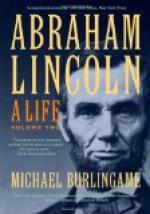Late on April 25 a squad of cavalry traced Booth to a barn in Virginia; they surrounded it, but he refused to come out; thereupon they set fire to it, and then one of them, Boston Corbett, contrary to orders, thrust his musket through a crevice and fired at Booth. Probably he hit his mark, though some think that the hunted wretch at this last desperate moment shot himself with his own revolver. Be this as it may, the assassin was brought forth having a bullet in the base of his brain, and with his body below the wound paralyzed. He died on the morning of April 26.
While the result of Booth’s shot secured for him that notoriety which he loved, the enterprise was in fact by no means wholly his own. A conspiracy involving many active members, and known also to others, had been long in existence. For months plans had been laid and changed, and opportunities had been awaited and lost. Had the plot not been thus delayed, its success might have done more practical mischief. Now, in addition to what the plotters lost by reason of this delay, only a part of their whole great scheme was carried out. At the same time that the tragedy was enacting at Ford’s Theatre an assault was perpetrated upon Mr. Seward, who was then confined to his bed by hurts lately received in an accident. The assassin gained admission into the house under pretense of bringing medicine; thus he reached the bedroom, and at once threw himself upon the secretary, whom he stabbed about the face and neck; then encountering in turn two sons of Mr. Seward and two men nurses, he wounded them all more or less seriously, and escaped. But much as had been done, as much or more was left undone; for there can be little doubt that the plot also included the murder of the Vice-President, General Grant, and Secretary Stanton; the idea being, so far as there was any idea or any sense at all in the villainy, that the sudden destruction of all these men would leave the government with no lawful head, and that anarchy would ensue.




